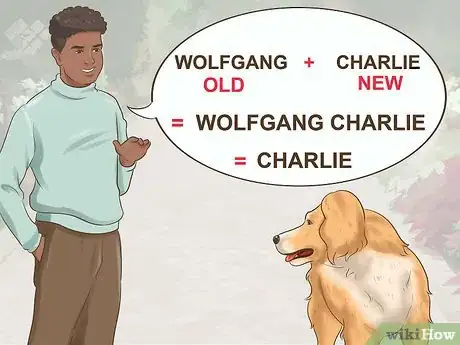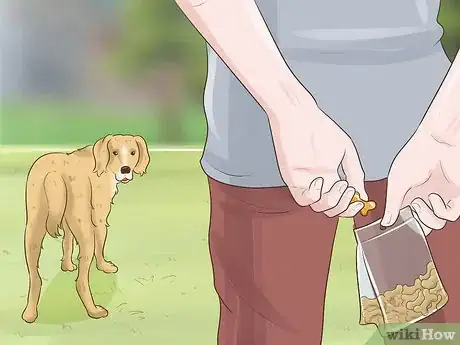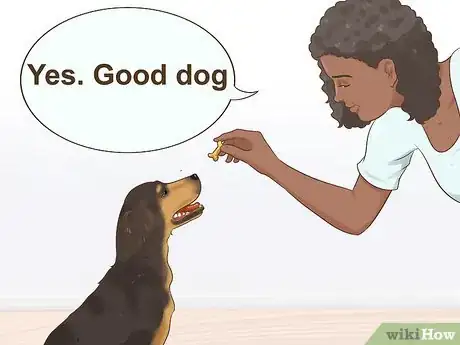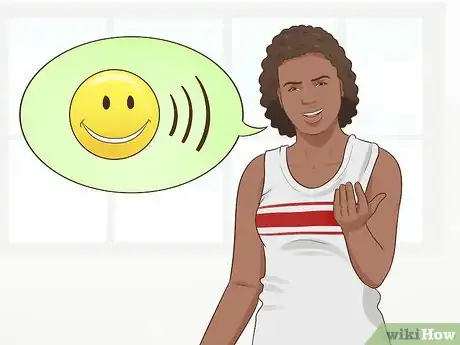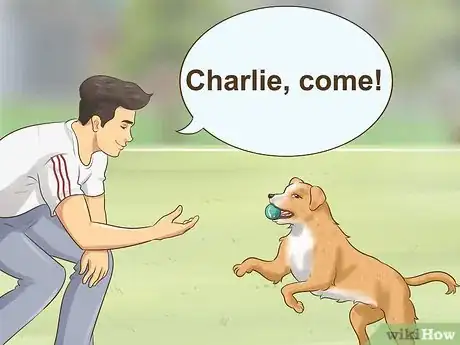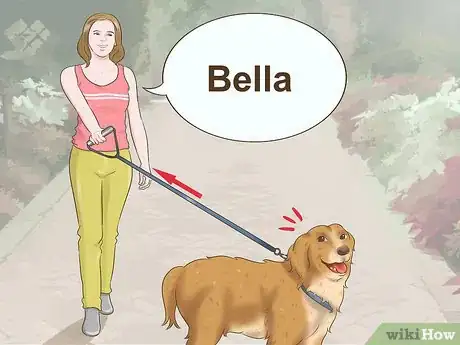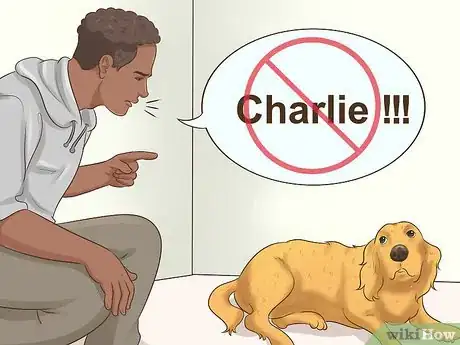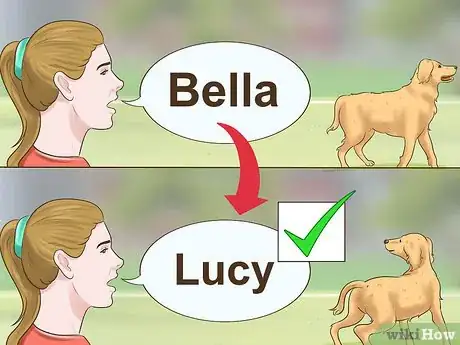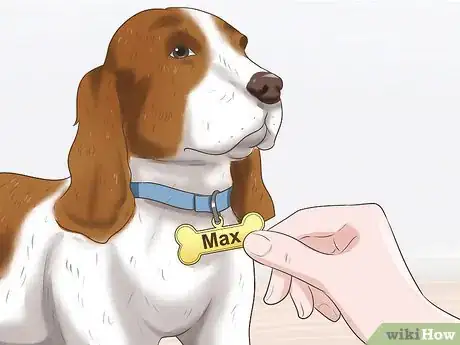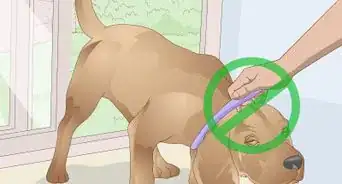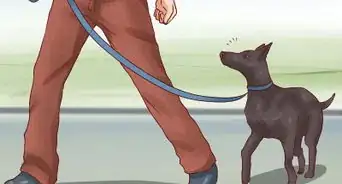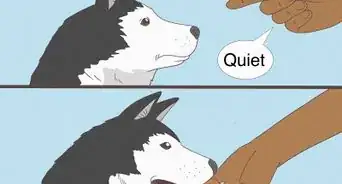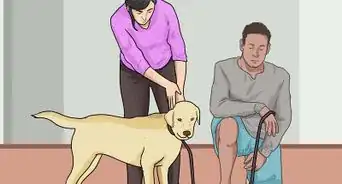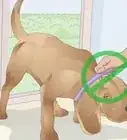This article was co-authored by Sophie Amphlett. Sophie Amphlett is a Professional Dog Trainer and Service Dog Coach with over five years of experience. Sophie graduated from CATCH Canine Trainers Academy’s Master Course with Distinction in 2016. She is also a Certified Trick Dog Instructor (CTDI) and a Certified Fun Scent Games Instructor (DN-FSG1). Sophie serves as a volunteer adoption counselor and dog walker for Adopt-A-Pet as well.
There are 9 references cited in this article, which can be found at the bottom of the page.
This article has been viewed 12,813 times.
Changing a dog’s name is not as difficult as it may seem. Dogs often respond to names like commands. If you want to change a dog's name, all you need are a few treats and a couple of days’ worth of training. Once you have decided on the new name, reward the dog when they respond to it. If the dog is stubborn or if the name does not seem to stick, you can try to encourage the dog in other ways.
Steps
Teaching Your Dog Their New Name
-
1Associate the new name with the old name. For the first week, you may need to call the dog both names. To do this, say the old name and the new name together. If the dog responds to this compound-name, you can start dropping the old name after about a week.[1]
- For example, if the dog’s old name is “Wolfgang” and their new name is “Charlie,” you should call them “Wolfgang Charlie.” After a week or two, you can just call them “Charlie.”
-
2Keep a few treats on you. For the first few days, you should always carry a few treats on you. This will let you test out their name at random moments during the day.[2] Some good treats to carry include:
- Small dog biscuits
- Cut-up pieces of cheese
- Small bits of meat
- Pieces of kibble
Advertisement -
3Call their name. Once or twice a day, at a random moment, call out the dog’s new name. Try to encourage the dog to look or come towards you. The best time to do it is when the dog is distracted with another task, such as chewing on a bone or sniffing something. This will teach the dog to respond to their name no matter what they are doing.[3]
- You can pair the new name with other, already known commands. For example, if your dog responds to the command "come," you can say, "Bella, comeǃ" Your dog will start to associate their name with responding to a command.
-
4Reward them when they come to you. If a dog understands their name correctly, they should stop what they are doing and come to you. While training the dog to respond to their new name, you should give them a treat whenever they come at the sound of their name. Once they come, say “Yes. Good dog” in a happy tone. Pet the dog, and give them a treat. This will teach them to associate their new name with good feelings, and they will start to respond even when there is not a treat.[4]
- Do not use the treat to bribe the dog to you. Only show the dog the treat once they have come over and you have praised them.
-
5Avoid using the name too often. It is important that the dog appropriately responds to their new name. While you should use the name often enough that they learn the name, you should not use their name all of the time. The dog may start to ignore the name if it is used too often. Good times to use the dog’s new name include:[5]
- When you are playing a recall game like fetch
- When you want them to come to you
- When using obedience commands such "sit," "down," or "come"
- When you are about to go on a walk
Reinforcing the New Name
-
1Say the name in a happy tone. When you say the dog’s new name, use a happy, pleasant tone. Act excited, and the dog will naturally respond. The dog will also begin to associate the name with pleasant emotions.[6]
-
2Play games with the new name. As you play with the dog, use the name when the dog returns to you. For example, if you are playing fetch, call the dog's name as they are running back to you with the ball in their mouth. This will teach them to associate their name with returning to you. Do not call their name while they are running to catch the ball or when the ball is in your hand, as this may confuse them.[7]
-
3Teach the dog their name on a leash. Most dogs will start responding to their new name within a few days, but if positive reinforcement isn’t working alone, you can try an exercise on the leash. Place the dog on a leash. Wait until they are distracted. Call their name. If the dog looks at you, reward them. If they do not, gently tug the leash while saying the name until they look at you. Say “Yes. Good dog,” and reward them with a treat. Keep doing this until they respond without you tugging at the leash.[8]
-
4Use a clicker to teach the dog its new name. Start by saying the dog's name, then click and give the dog a treat. Do this several times. At some point, when you say the name, the dog will look at you—click at that precise moment and give the dog a treat. This will teach them that the name is a word they should pay attention to.[9]
- It will also reinforce the concept of clicker training with the dog.[10]
-
5Avoid using the name when punishing the dog. To encourage your dog to respond to the new name, it should be associated with pleasant feelings. Do not use the name when punishing, yelling, or disciplining your dog. Otherwise, the dog may grow scared or anxious when they hear their name.
- If your dog is getting into trouble, instead of using their name, come up with different correction sounds instead. These can be hissing noises (like “tsst” or "nuh-uh") or a disruptive verbal command (such as “hey” or “no”).[11]
-
6Change the name again if necessary. If after several weeks, the dog is still not responding to the new name, you may need to try again with a different name. Dogs are capable of responding to multiple names, and it will not negatively affect the dog if you change the name again. Try to come up with a different, more distinct name, and begin training again.[12]
- Do not change your dog's name on a whim. Good reasons to change a dog's name include recent adoption into a new family, a lack of response from the dog towards their old name, or an association between the name and an abusive situation.
Establishing Their New Name
-
1Find a simple name. The transition to a new name will go more smoothly if you choose a simple, easily recognizable name. Make sure that the name is no more than two syllables long. You may not want to choose a name that sounds like a command (for example, if you name a dog “Mitt,” he might confuse the name with “sit.”)[13] Some popular dog names include:
- Bella
- Ollie
- Max
- Ace
- Bailey
- Jack
- Shiloh
- Shadow
- Nova
-
2Choose a new name that has the same first syllable as the old name. It may also be easier for your dog to learn his new name if it has the same first syllable as the old name. For example, if your dog’s name was Lucky, then you may find it easy to change it to Lucy. Or, if the dog’s name was Betsy, then you could change it to Bella.
-
3Tell others what the dog's new name is. To help teach your dog their new name, it is important that everybody calls them by this name instead of their old one. Inform your friends, family members, and vet of the new name, so that they do not call the dog by the wrong name.
-
4Create a dog-tag with their new name. While your dog cannot read, it is important to put a dogtag on their collar with the new name as soon as possible. This will encourage other people to call them by the new name, thus reinforcing what their name is. Furthermore, if the dog becomes lost, others will be able to call the dog and return them to you.[14]
Expert Q&A
Did you know you can get expert answers for this article?
Unlock expert answers by supporting wikiHow
-
QuestionCan you rename a dog you adopted?
 Sophie AmphlettSophie Amphlett is a Professional Dog Trainer and Service Dog Coach with over five years of experience. Sophie graduated from CATCH Canine Trainers Academy’s Master Course with Distinction in 2016. She is also a Certified Trick Dog Instructor (CTDI) and a Certified Fun Scent Games Instructor (DN-FSG1). Sophie serves as a volunteer adoption counselor and dog walker for Adopt-A-Pet as well.
Sophie AmphlettSophie Amphlett is a Professional Dog Trainer and Service Dog Coach with over five years of experience. Sophie graduated from CATCH Canine Trainers Academy’s Master Course with Distinction in 2016. She is also a Certified Trick Dog Instructor (CTDI) and a Certified Fun Scent Games Instructor (DN-FSG1). Sophie serves as a volunteer adoption counselor and dog walker for Adopt-A-Pet as well.
Professional Dog Trainer Absolutely. It helps to use a clicker. Say the new name—let's say it's "Bob." You'd say "Bob," then click the clicker and immediately give the dog a treat. After multiple repetitions of this, when you say "Bob," the dog is going to look at you. At the moment the dog acknowledges its name, click the clicker and give it a treat. That will teach the dog that "Bob" is a word worth paying attention to.
Absolutely. It helps to use a clicker. Say the new name—let's say it's "Bob." You'd say "Bob," then click the clicker and immediately give the dog a treat. After multiple repetitions of this, when you say "Bob," the dog is going to look at you. At the moment the dog acknowledges its name, click the clicker and give it a treat. That will teach the dog that "Bob" is a word worth paying attention to.
Warnings
- Make sure everyone in the household knows what the dog’s new name is. It may disrupt the training if somebody is trying to train the dog with a different name.⧼thumbs_response⧽
- The dog should respond right away to their name. If they ignore you and only come to you when you bribe them with a treat, they are not learning their name properly.⧼thumbs_response⧽
- Do not flip-flop between the old and new name. Either use the old name in combination with the new name (such as "Wolfgang Charlie") or exclusively use the new name. Do not call the dog their old name during one situation and their new name during another.⧼thumbs_response⧽
References
- ↑ http://www.cnn.com/2012/08/09/living/change-dogs-name-mnn/
- ↑ https://www.petfinder.com/dogs/bringing-a-dog-home/changing-dog-name/
- ↑ http://www.puplife.com/pages/how-to-teach-your-dog-to-recognize-their-name
- ↑ https://www.petfinder.com/dogs/bringing-a-dog-home/changing-dog-name/
- ↑ http://www.puplife.com/pages/how-to-teach-your-dog-to-recognize-their-name
- ↑ http://www.cnn.com/2012/08/09/living/change-dogs-name-mnn/
- ↑ http://www.cnn.com/2012/08/09/living/change-dogs-name-mnn/
- ↑ http://www.puplife.com/pages/how-to-teach-your-dog-to-recognize-their-name
- ↑ Sophie Amphlett. Professional Dog Trainer. Expert Interview. 30 December 2020.
- ↑ Sophie Amphlett. Professional Dog Trainer. Expert Interview. 30 December 2020.
- ↑ http://theroanoker.com/blogs/behind/dog-trainer-series-name-use-and-corrections/
- ↑ http://www.cnn.com/2012/08/09/living/change-dogs-name-mnn/
- ↑ http://www.petmd.com/dog/puppycenter/adoption/evr_dg_naming_your_puppy
- ↑ http://www.puplife.com/pages/how-to-teach-your-dog-to-recognize-their-name
About This Article
To train your new dog to respond to a new name, try saying its old name and new name together to encourage it to respond. After a week or two, drop the old name, since it should be used to hearing the new one by then. You should also carry a few treats with you, like dog biscuits or pieces of cheese, so you can reward it when it responds. Whenever you reward your dog, say something like “Yes, good dog” in a positive voice to reinforce its good behavior. Once your dog starts responding, try calling its name when its distracted by something else, such as a bone or a toy, so that it learns to come to you no matter what it’s doing. For tips from our Veterinary co-author on how to teach your dog its new name on a leash, keep reading!
